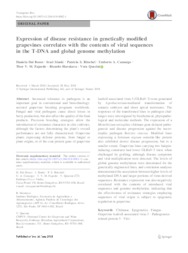Expression of disease resistance in genetically modified grapevines correlates with the contents of viral sequences in the T-DNA and global genome methylation.
Expression of disease resistance in genetically modified grapevines correlates with the contents of viral sequences in the T-DNA and global genome methylation.
Author(s): BOSCO, D. D.; SINSKI, I.; RITSCHEL, P. S.; CAMARGO, U. A.; FAJARDO, T. V. M.; HARAKAVA, R.; QUECINI, V.
Summary: Increased tolerance to pathogens is an important goal in conventional and biotechnology-assisted grapevine breeding programs worldwide. Fungal and viral pathogens cause direct losses in berry production, but also affect the quality of the final products. Precision breeding strategies allow the introduction of resistance characters in elite cultivars, although the factors determining the plant?s overall performance are not fully characterized. Grapevine plants expressing defense proteins, from fungal or plant origins, or of the coat protein gene of grapevine leafroll-associated virus 3 (GLRaV-3) were generated by Agrobacterium -mediated transformation of somatic embryos and shoot apical meristems. The responses of the transformed lines to pathogen challenges were investigated by biochemical, phytopathological and molecular methods. The expression of a Metarhizium anisopliae chitinase gene delayed pathogenesis and disease progression against the necrotrophic pathogen Botrytis cinerea. Modified lines expressing a Solanum nigrum osmotin-like protein also exhibited slower disease progression, but to a smaller extent. Grapevine lines carrying two hairpin- inducing constructs had lower GLRaV-3 titers when challenged by grafting, although disease symptoms and viral multiplication were detected. The levels of global genome methylation were determined for the genetically engineered lines, and correlation analyses demonstrated the association between higher levels of methylated DNA and larger portions of virus-derived sequences. Resistance expression was also negatively correlated with the contents of introduced viral sequences and genome methylation, indicating that the effectiveness of resistance strategies employing sequences of viral origin is subject to epigenetic regulation in grapevine. Keywords Chitinase, Epigenetics, Fungus, Grapevine leafroll-associated virus 3, Pathogenesis related protein 5, Vitis
Publication year: 2018
Types of publication: Journal article
Unit: Embrapa Grape & Wine
Observation
Some of Embrapa's publications are published as ePub files. To read them, use or download one of the following free software options to your computer or mobile device. Android: Google Play Books; IOS: iBooks; Windows and Linux: Calibre.
Access other publications
Access the Agricultural Research Database (BDPA) to consult Embrapa's full library collection and records.
Visit Embrapa Bookstore to purchase books and other publications sold by Embrapa.

